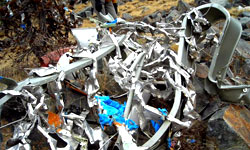NTSB findings: Steve Fossett
#1
NTSB says downdrafts killed Fossett
By Alton K. Marsh

The National Transportation Safety Board has determined in a report that adventurer Steve Fossett was most likely killed while trying to escape downdrafts that exceeded the performance of his Bellanca 8KCAB Decathlon.
Examination of the site indicated Fossett made a 180-degree turn after radar contact was lost. (After the accident was discovered in October 2008, a review of radar tracks showed one 20-minute track to be within one mile of the site.) Additionally, downdrafts in the area were 400 feet per minute, and Fossett’s Decathlon was capable of climbing at only 300 fpm given the density altitude at its cruising altitude.
Fossett departed the Flying M Ranch near Yerington, Nev., on Sept. 3, 2007, for a personal flight that some said was to scout a location for a land speed record attempt. The flight was later found to end at a mountain site Fossett knew as a boy. A month-long search failed to find the aircraft. Hikers found Fossett’s personal effects on a mountain at 10,000 feet about a half-mile from where the aircraft remains were later discovered. The radar track nearest the accident site indicated the aircraft had been flying at 13,000 ft.
By Alton K. Marsh

The National Transportation Safety Board has determined in a report that adventurer Steve Fossett was most likely killed while trying to escape downdrafts that exceeded the performance of his Bellanca 8KCAB Decathlon.
Examination of the site indicated Fossett made a 180-degree turn after radar contact was lost. (After the accident was discovered in October 2008, a review of radar tracks showed one 20-minute track to be within one mile of the site.) Additionally, downdrafts in the area were 400 feet per minute, and Fossett’s Decathlon was capable of climbing at only 300 fpm given the density altitude at its cruising altitude.
Fossett departed the Flying M Ranch near Yerington, Nev., on Sept. 3, 2007, for a personal flight that some said was to scout a location for a land speed record attempt. The flight was later found to end at a mountain site Fossett knew as a boy. A month-long search failed to find the aircraft. Hikers found Fossett’s personal effects on a mountain at 10,000 feet about a half-mile from where the aircraft remains were later discovered. The radar track nearest the accident site indicated the aircraft had been flying at 13,000 ft.
#2
Mountain flying is more dangerous than most pilots truly realize. Sparky Imeson died a couple of months ago flying in the mountains, and he is of course the most respected mountain aviator of all time. The only good thing about this is, he supposedly did so by not adhering to his own wisdom on the subject. You have to wonder if achievement is related to personal daring when things like this happen.
Thread
Thread Starter
Forum
Replies
Last Post
MDT06
Regional
46
09-26-2008 06:59 AM





